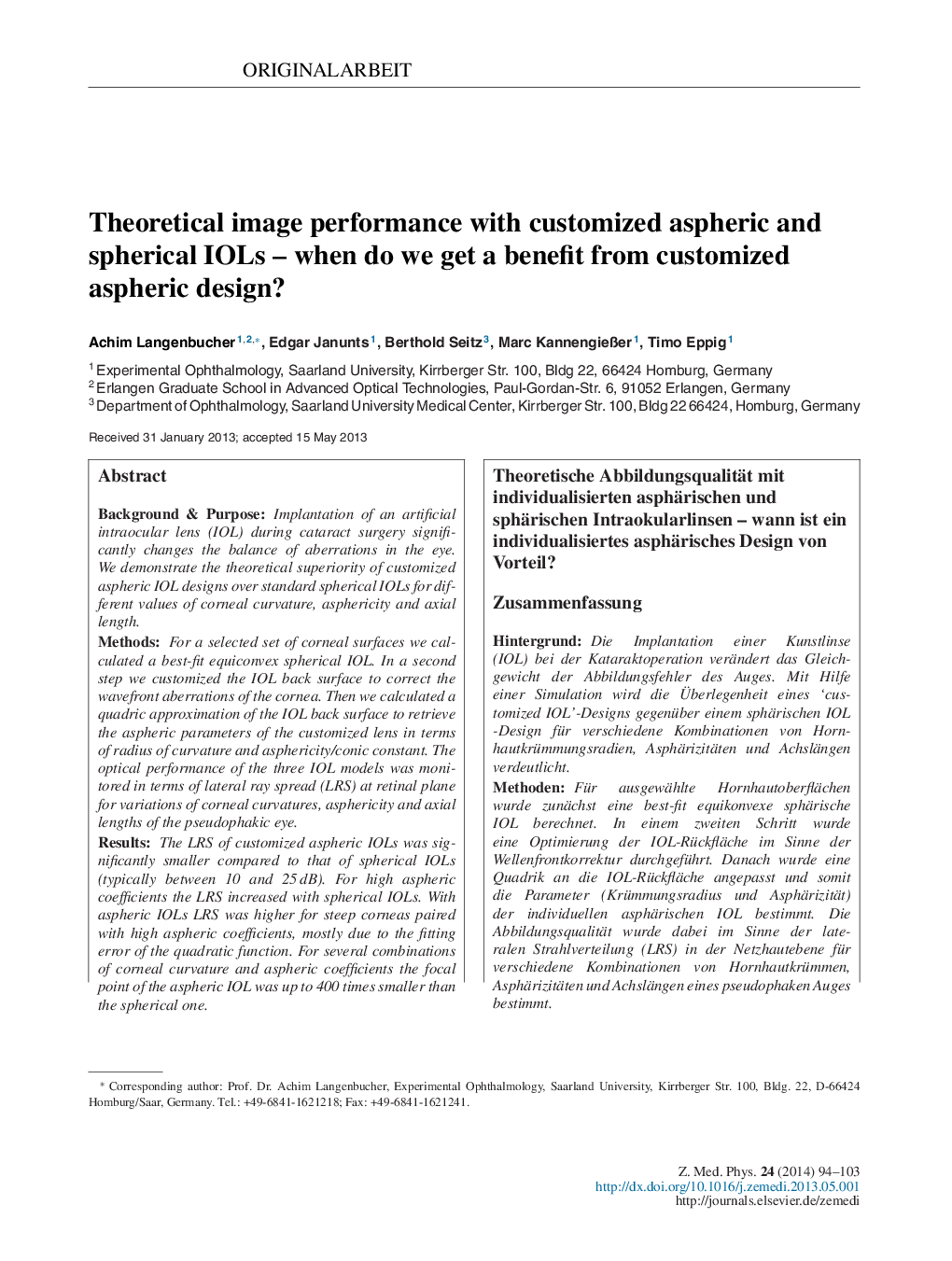| کد مقاله | کد نشریه | سال انتشار | مقاله انگلیسی | نسخه تمام متن |
|---|---|---|---|---|
| 1894993 | 1044264 | 2014 | 10 صفحه PDF | دانلود رایگان |

Background & PurposeImplantation of an artificial intraocular lens (IOL) during cataract surgery significantly changes the balance of aberrations in the eye. We demonstrate the theoretical superiority of customized aspheric IOL designs over standard spherical IOLs for different values of corneal curvature, asphericity and axial length.MethodsFor a selected set of corneal surfaces we calculated a best-fit equiconvex spherical IOL. In a second step we customized the IOL back surface to correct the wavefront aberrations of the cornea. Then we calculated a quadric approximation of the IOL back surface to retrieve the aspheric parameters of the customized lens in terms of radius of curvature and asphericity/conic constant. The optical performance of the three IOL models was monitored in terms of lateral ray spread (LRS) at retinal plane for variations of corneal curvatures, asphericity and axial lengths of the pseudophakic eye.ResultsThe LRS of customized aspheric IOLs was significantly smaller compared to that of spherical IOLs (typically between 10 and 25 dB). For high aspheric coefficients the LRS increased with spherical IOLs. With aspheric IOLs LRS was higher for steep corneas paired with high aspheric coefficients, mostly due to the fitting error of the quadratic function. For several combinations of corneal curvature and aspheric coefficients the focal point of the aspheric IOL was up to 400 times smaller than the spherical one.ConclusionThis study appeals to the reader for the potential benefit of customized aspheric IOL design instead of the principle of a ‘one size fits all’ aspheric coefficient as used currently in clinical practice. A benefit with customized IOLs is less depending from the axial length and can be achieved with corneas of a moderate prolate aspheric shape with an equal or more negative Q value than the average of -0.22. Longer eyes seem to benefit less than short eyes.
ZusammenfassungHintergrundDie Implantation einer Kunstlinse (IOL) bei der Kataraktoperation verändert das Gleichgewicht der Abbildungsfehler des Auges. Mit Hilfe einer Simulation wird die Überlegenheit eines ‘customized IOL’-Designs gegenüber einem sphärischen IOL-Design für verschiedene Kombinationen von Hornhautkrümmungsradien, Asphärizitäten und Achslängen verdeutlicht.MethodenFür ausgewählte Hornhautoberflächen wurde zunächst eine best-fit equikonvexe sphärische IOL berechnet. In einem zweiten Schritt wurde eine Optimierung der IOL-Rückfläche im Sinne der Wellenfrontkorrektur durchgeführt. Danach wurde eine Quadrik an die IOL-Rückfläche angepasst und somit die Parameter (Krümmungsradius und Asphärizität) der individuellen asphärischen IOL bestimmt. Die Abbildungsqualität wurde dabei im Sinne der lateralen Strahlverteilung (LRS) in der Netzhautebene für verschiedene Kombinationen von Hornhautkrümmen, Asphärizitäten und Achslängen eines pseudophaken Auges bestimmt.ErgebnisseDie LRS des individuellen asphärischen IOL-Designs war signifikant kleiner als die der sphärischen IOL (typischerweise zwischen 10 und 25 dB). Für hohe Asphärizitäten stieg LRS mit der sphärischen IOL an. Bei der asphärischen IOL zeigte die LRS höhere Werte für steile Hornhautkrümmungen in Kombination mit hohen Asphärizitäten. Dies lässt sich auf einen Anpassungsfehler beim Least-Squares-Ansatz zurückführen. Für verschiedene Kombinationen von Hornhautkrümmungsradien und Asphärizitäten erzeugte die individuelle asphärische IOL einen bis zu 400-fach kleineren Fokuspunkt als die sphärische IOL.ZusammenfassungMit dieser Studie wird dem Leser der theoretische Nutzen einer individualisierten asphärischen IOL gegenüber der momentan gängigen „one size fits all“ asphärischen IOL verdeutlicht. Der theoretische Nutzen einer individualisierten IOL ist nur gering abhängig von der Achslänge des Auges und kann insbesondere mit einer moderat prolat asphärischen Hornhaut erreicht werden, deren Asphärizität leicht negativer ausfällt als der Normalwert von -0,22. Lange Augen scheinen von einer individuellen Kunstlinse weniger zu profitieren als kurze Augen.
Journal: Zeitschrift für Medizinische Physik - Volume 24, Issue 2, May 2014, Pages 94–103